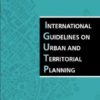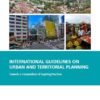International Guidelines on Urban and Territorial Planning

The International Guidelines on Urban and Territorial Planning serve both as a source of inspiration and a compass for decision makers and urban professionals when reviewing urban and territorial planning systems. The Guidelines provide national governments, local authorities, civil society organizations and planning professionals with a global reference framework that promotes more compact, socially inclusive, better integrated and connected cities and territories that foster sustainable urban development and are resilient to climate change.
 The drafting of the Guidelines was supported by a Group of 35 Experts including ISOCARP VPs Shipra Narang Suri and Shi Nan, over two years through a broad-based consultative and participatory process and based on evidence, good practices and lessons learnt from different contexts and at different planning scale. A Compendium of inspiring practices has been developed by the Expert Group to illustrate the principles and recommendations included in the Guidelines.
The drafting of the Guidelines was supported by a Group of 35 Experts including ISOCARP VPs Shipra Narang Suri and Shi Nan, over two years through a broad-based consultative and participatory process and based on evidence, good practices and lessons learnt from different contexts and at different planning scale. A Compendium of inspiring practices has been developed by the Expert Group to illustrate the principles and recommendations included in the Guidelines.
Source: UN-HABITAT
Tools for Integrated and Participatory Urban Planning
 The Lab started as a technical team developing concrete planning projects. It has been evolving into a program with a distinct approach and activities at global and local level, developing eventually into the Network of UPD Labs associated directly or indirectly. Its methodology is based on a strong project approach that integrates different sectoral demands and brings stakeholders and citizens together. The design of clear proposals is therefore accelerated and ready for implementation on the short and medium term. After these proposals have been tested and evaluated, the lessons learnt are translated and incorporated to the policies and principles of the Agency, contributing to the implementation of the New Urban Agenda.
The Lab started as a technical team developing concrete planning projects. It has been evolving into a program with a distinct approach and activities at global and local level, developing eventually into the Network of UPD Labs associated directly or indirectly. Its methodology is based on a strong project approach that integrates different sectoral demands and brings stakeholders and citizens together. The design of clear proposals is therefore accelerated and ready for implementation on the short and medium term. After these proposals have been tested and evaluated, the lessons learnt are translated and incorporated to the policies and principles of the Agency, contributing to the implementation of the New Urban Agenda.
This publication aims to present the Lab´s approach towards planning and design, management and implementation, as well as to introduce the trajectory of the UN-Habitat’s Lab through its working years of experience.